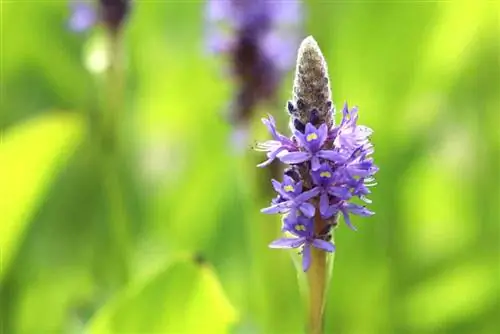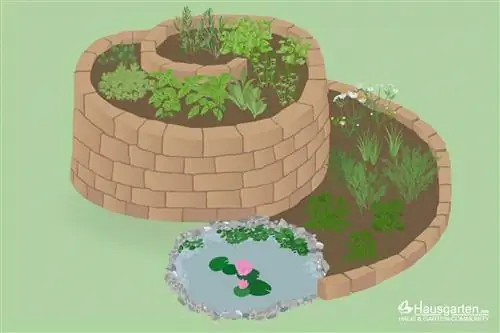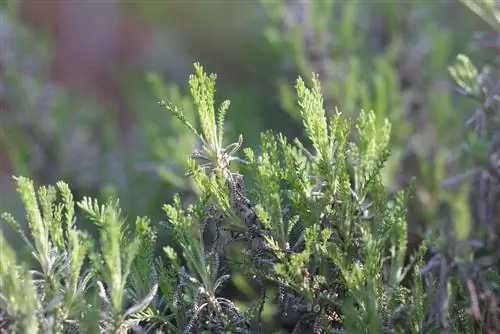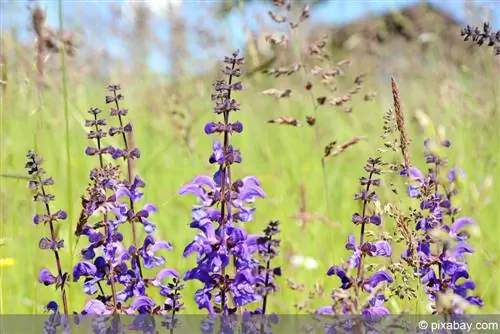- Author admin [email protected].
- Public 2023-12-17 03:39.
- Last modified 2025-01-24 12:45.
Pike herb or Pontederia cordata, as the plant is called in botanical terminology, can grow in water up to 30 centimeters deep and therefore thrives primarily on the banks of lakes and ponds. Here the plant fulfills important functions, such as acting against algae. But what should you pay attention to when caring for and overwintering and is the plant poisonous?
The right location
The plant requires permanently wet soil, but should only be at a maximum water depth of 30 centimeters. The plant is therefore ideal for the bank area of the garden pond. It tolerates both full sun and partial shade locations. Sandy, muddy and nutrient-rich soil should be used as a substrate.
Tip:
If you want to prevent the Pontederia cordata from spreading too far, you can also place it in a planter in the pond. This limits the roots and provides more substrate for the plant.
When to plant pikeweed?
Pontederia cordata should be used when the water surface is no longer expected to freeze over. In mild regions this is already the case very early. A time between March and May is usually ideal.
Care
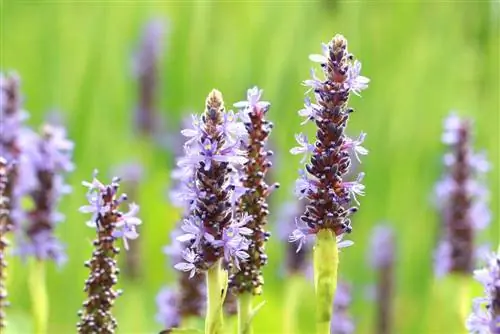
If the Pontederia cordata is in the water of the garden pond, it obviously doesn't need to be watered. There is also no need to fertilize, as it is supplied with nutrients by other decomposing plants and possibly the feces of fish and other pond inhabitants.
If the herbaceous plant is cultivated in a bucket, various care steps must be taken into account. These include:
- Keep substrate wet or at least well moist
- use soft, low-lime water
- Use fertilizers specifically for pond plants during the growth phase
Fertilization is carried out according to the manufacturer's instructions and depending on the fertilizer chosen, but usually every two weeks.
Blooming time of the pikeweed
The flowering period of Pontederia cordata usually falls between June and August. The plant has blue to purple spike-shaped flowers that are vaguely reminiscent of lavender and are extremely decorative. In addition to the attractive leaf shape and the practical functions in the pond, it is mainly due to the flowering period that the plant is one of the most popular plants for the garden pond.
Tip:
The flowering can be extended if a very sunny and protected location is chosen for the plant.
Cut
At the end of the growth phase, the above-ground parts of the Pontederia cordata dry out and can then be cut. During growth, dried, broken or otherwise damaged plant parts should also be removed. This is particularly useful when cultivating in ponds so as not to add more nutrients to the water through decomposing plant parts.
Overwintering Pontederia cordata
Pike weed plants are not hardy and therefore cannot tolerate frost. When temperatures drop, the plant retreats into the so-called rhizome and the above-ground parts dry out or wither. For successful wintering, the following points should be taken into account:
- All dried parts of the plant must be removed. Scissors or a sharp knife should be used for this. In any case, the chosen cutting tool must be clean so as not to transmit diseases to the crop.
- Pontederia cordata is removed from the pond with the surrounding substrate. Here, too, it is practical if it was left in a planter. Otherwise it should now be placed in a pot with the rhizome completely covered by soil.
- The plant is placed in a larger pot, a bucket or an aquarium and covered with soft, low-lime water.
- Overwintering takes place in a frost-free place. Temperatures between 5 and 10°C are ideal. Since the pike herb has already retreated into the rhizome, it can also be overwintered in a dark room. Because the plant is not winter hardy, only freedom from frost is crucial.
- During the winter, care should be taken to ensure that the substrate does not dry out and is constantly at least slightly moist. However, it may also be completely covered with water. Watering should only be done with water that is at the same temperature as the plant and substrate. It is ideal if it stands in the same room for at least a few hours and can therefore reach the appropriate temperature.
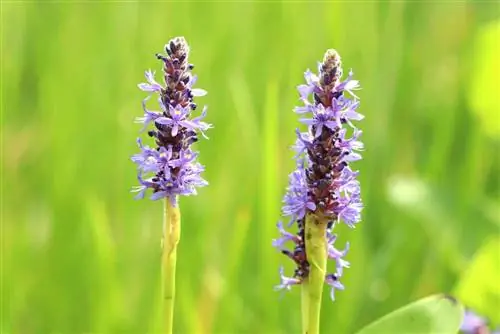
In spring, when the pond is no longer expected to freeze over, the plant can be placed outside in the water again. When cultivating in a bucket, you should wait for the last late frosts, as the water surface freezes much faster in smaller containers than in a pond.
Propagation
Pontederia cordata forms a so-called creeping rhizome and also reproduces through it. So further shoots emerge from the root. If the pike herb is to be propagated, it simply needs to be separated from the mother plant. Proceed as follows:
- Take the plant out of the water and rinse the substrate from the roots.
- Using a sharp, clean knife, divide the rhizome so that both mother and daughter plants receive as much root mass as possible.
- Let the interfaces air dry for a few hours.
- Put the now divided plants back into the substrate separately and plant them in the bank area or pot.
The best time for propagation is when the daughter plants are already 10 to 20 centimeters high.
Another way to propagate pikeweed is to plant seeds. However, you have to wait significantly longer until the first young plants appear. The seeds can be collected after flowering in summer and should be stored in a cool and dry place over autumn and winter. When the plants are ready to be put back outdoors, the seeds can also be placed in permanently wet substrate and grown here.
Tip:
The young plants should also be planted directly in a container and not placed freely in the pond, so that on the one hand uncontrolled reproduction is avoided and on the other hand overwintering is made easier.
Is pike weed poisonous?
No, neither the leaves nor the seeds of the plant are poisonous. Therefore, the plant is easily suitable for the pond or pot even if children and pets use the garden to play and could accidentally tear off parts of the plant. In fact, the leaves and seeds of Pontederia cordata are even edible, so the plant can be cultivated without any concerns.
Functions in the pond
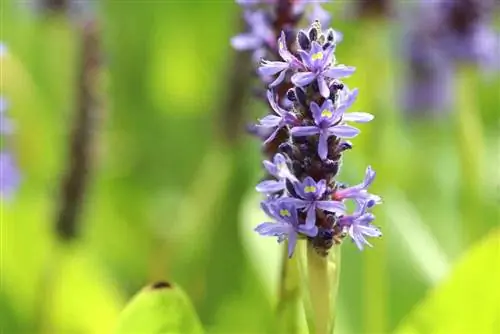
The pike herb is not only extremely decorative thanks to its leaves and flowers, but also fulfills important functions in the garden pond. For example:
Effect against algae
Since the plant removes nutrients from the water, it acts against algae or can at least reduce their spread.
Hideouts for pond inhabitants
The stems and leaves of the plant offer hiding places for pond inhabitants, and they are also possible spawning places. This offers protection to the living creatures in the garden pond.
Fixing the bank area
The creeping rhizome attaches the substrate to the bank area. However, this only applies if the plant is not grown in a container.
Pests and diseases
There is no need to expect diseases or pests with the plant because it is very robust and insensitive to infestation or infection. The only potential problem is found in aphids, which can cause damage to the leaves and stems. To combat this, there are remedies available from specialist retailers. However, a natural alternative can be found in predators such as ladybirds. These do not harm the plants and do not pose a danger to the water in the garden pond, but can also be purchased from specialist retailers and used specifically. Care should also be taken to ensure that the plant is not winter hardy.

